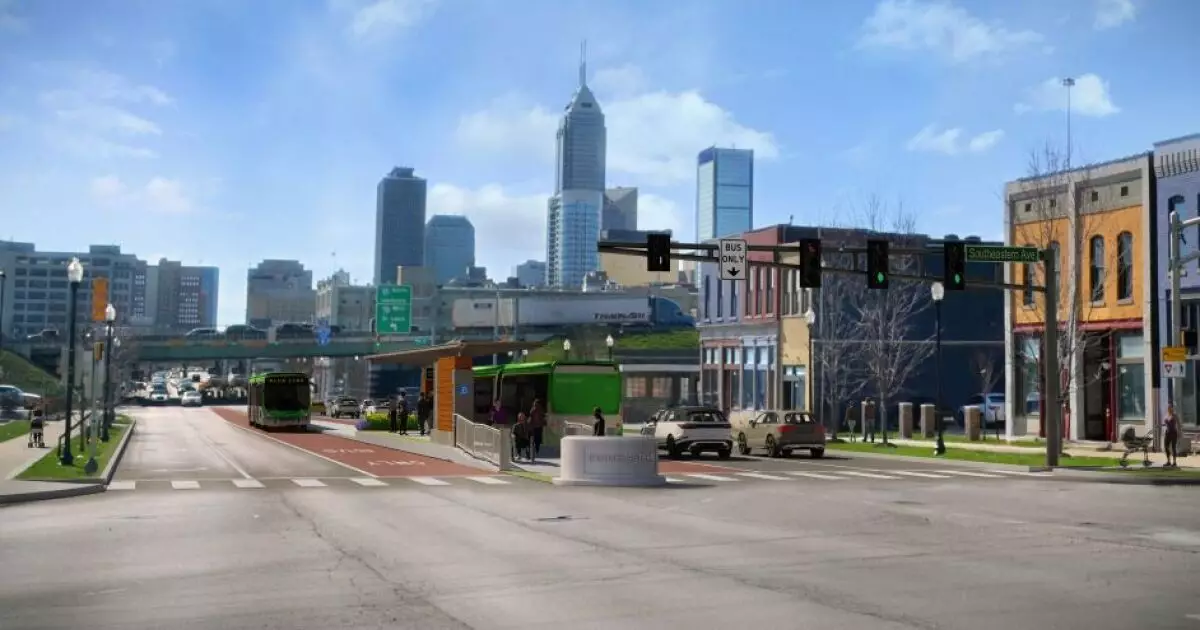The recent announcement surrounding the $125 million bond issuance to finance an ambitious bus rapid transit project in Indianapolis evokes both optimism and caution. While on the surface it appears as a bold step towards enhancing public transit, deeper scrutiny reveals a more nuanced and troubling financial situation as municipal market dynamics shift. IndyGo, representing the public transportation aspirations of a vibrant urban center, finds itself at a crossroads where the potential for improved mobility must be carefully balanced with the impending economic realities indicated by recent bond market turbulence.
The prevailing narrative championing public transit as both an environmental and social good is compelling; however, it warrants rigorous examination. The bonds to fund the Blue Line Bus Rapid Transit (BRT) project come with an AA-minus rating from S&P Global Ratings, a reassuring badge of credibility in ordinary times. Nevertheless, today’s prevailing economic conditions—characterized by rising municipal yields driven by tariff-induced volatility—cast a shadow over financial forecasts. The pause in pricing underscores a significant hesitance from bond managers and investors alike. This moment of indecision raises critical questions about the underlying stability of IndyGo’s revenue streams, particularly when justifying the funding mechanisms derived from local income taxes in an increasingly volatile market.
Evaluating the Project’s Necessity
The Blue Line project is certainly ambitious, promising to extend service over 24 miles, connecting residents to crucial hubs from the Indianapolis International Airport to downtown. However, this enthusiasm deserves scrutiny. What is the real necessity of this rapid bus line at this moment? With public transit ridership only recovering to about 75% of pre-pandemic levels, some critics may argue that the focus should pivot back to ensuring the stability of existing services instead of extending them.
Moreover, the fundamental question looms: Is this investment in new infrastructure truly what the citizens of Marion County need? The allure of a shiny new transit line may overshadow more pressing issues, such as improving the frequency and reliability of current transit services. Critics might contend that the resources allocated to new projects could instead be directed towards rectifying inefficiencies or enhancing accessibility for the most underserved communities.
Furthermore, the notion of bus rapid transit promising light rail-like service without the hefty price tag deserves a real-world examination. Without proper evaluations of ridership demand and usage patterns, there is a significant risk that the investment could outpace its benefits. In an age when taxpayers demand transparent accountability, such large-scale projects necessitate a robust discussion informed by data.
Revenue Streams under Scrutiny
The financial underpinnings of IndyGo’s operation—the local income tax as the backbone of its bond repayment—add another layer of complexity to this narrative. While the City-County Council’s pledge of local tax revenues appears to safeguard bondholders initially, it also places pressure on the Marion County residents who will implicitly bear the cost of this ambitious project. In essence, local income taxes intended to bolster community welfare are now being scrutinized as potential liabilities.
The bonds are secured by a first-lien pledge of a 0.25% transportation local income tax revenue stream, but S&P’s analyst Andrew Stafford has flagged rising liquidity needs if revenues fail to meet expectations. Though the forecast remains optimistic for steady revenue growth due to a low volatility tax stream, the specter of economic downturn looms large. If IndyGo’s farebox recovery ratio—a mere 5% of its total revenue—is any indication, reliance on local taxes without a diverse revenue model presents significant risk.
With more than $209 million in long-term debt expected following this transaction, the weight of financial commitments cannot be understated. Should economic conditions worsen, or if the projected ridership fails to materialize, the very system purported to uplift the residents of Indianapolis could find itself under heavy strain.
The Dangers of Ambitious Overreach
As we dissect IndyGo’s bold leap towards revitalized public transit, it’s crucial to reflect on whether such ambitious undertakings might lead to overreach. The allure of progress should not eclipse a grounded approach to fiscal responsibility. When special funds and reserves are utilized to back debt, they must be rigorously defended to prevent any lapse that could compromise the service’s viability.
It’s imperative for city planners and taxpayers alike to demand clarity and prudence regarding the project’s long-term operational and financial impacts. Until voters see clear evidence that the Blue Line BRT will enhance their daily lives and not exacerbate fiscal burdens, the push for such sweeping transformations should be approached with tempered enthusiasm and heightened vigilance.
In a world facing economic uncertainties and shifting transit dynamics, it’s essential we advocate for a sensible, long-term vision that prioritizes usability, sustainability, and fiscal transparency above all else. The journey ahead for Indianapolis’ public transit remains laden with potential pitfalls—it’s up to the community to remain engaged and questioning.


Leave a Reply